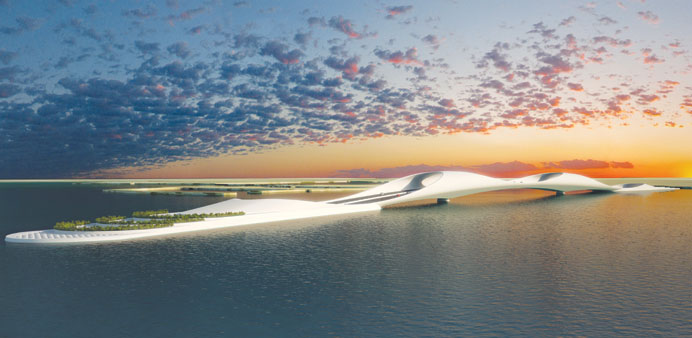A view of the Sharq Crossing from its southern end.
By Ramesh Mathew
Giving a fillip to Qatar’s preparations to host the 2022 FIFA World Cup, Ashghal yesterday unveiled the nearly 12km-long multibillion Sharq Crossing project, which is intended to enable fast mobility between the fast-developing West Bay areas and the new Hamad International Airport (HIA).
“Work is expected to begin some time in 2015, after completing all necessary formalities during 2014, with an expected completion by 2021,” Ashghal president and senior engineer Nasser bin Ali al-Mawlawi announced in the presence of HE the Minister of Municipality and Urban Planning Sheikh Abdulrahman bin Khalifa bin Abdulaziz al-Thani and many senior Ashghal officials and diplomats.
“The architectural marvel consists of three iconic bridges, connected to each other by underwater state-of-the-art tunnels of more than 10km,” he explained.
Terming Sharq Crossing as one of the most ambitious engineering marvels ever undertaken in the whole of the Middle East region, Ashghal chief said the three bridges, which together forms the massive project would link the HIA, scheduled for soft opening early next year, with Katara Cultural Village in northern Doha and central business districts of the West Bay.
The three inter-connection bridges on the route would be between 600 and 1,310m in length, and Al Sharq, the one linking it directly with the HIA, would be the largest. The sub-sea tunnels would be about 8-9km long.
The most intricately designed of the trio, the West Bay bridge will be a two-deck arched structure, featuring a recreational park to be accessed through an elevated walkway and a funicular cable way. It will also house hospitality and recreational facilities that would eventually make the most of the panoramic view of the city’s skyline.
The sub-sea tunnels which constitute the most important link of the major project would provide a three-lane expressway in each direction between the HIA and West Bay and two lanes each between West Bay and Lusail.
The West Bay bridge would stand at an 120m elevation and two of its spans would separate each other at a record distance of more than 700m.
The 12km project is designed by the widely acclaimed architect, artist and engineering consultant from Valencia in Spain, Santiago Calatrava, who has an array of universally-acknowledged architectural masterpieces to his credit, including Bache de Roda Bridge of Barcelona, Alamillo Bridge and Cartuja Viaduct (Seville), Campo Volantin footbridge (Bilbao) and Alameda Bridge (Valencia) among others.
A number of ongoing projects of Calatrava are in different stages of construction in the US, Italy, Brazil, and Chinese Taipei and many other countries.
At yesterday’s meeting where the salient features of the project were announced, al-Mawlawi said it would be considered as the most technologically advanced building and complex programmes to be undertaken so far by Ashghal to enhance the country’s transport network in line with the goals and objectives of the Qatar National Vision 2030.
“While providing an important new artery to Doha’s existing road network, the Sharq Crossing will be instantly recognisable across the world and is certain to be an epic landmark for Qatar,” the senior engineer added.

